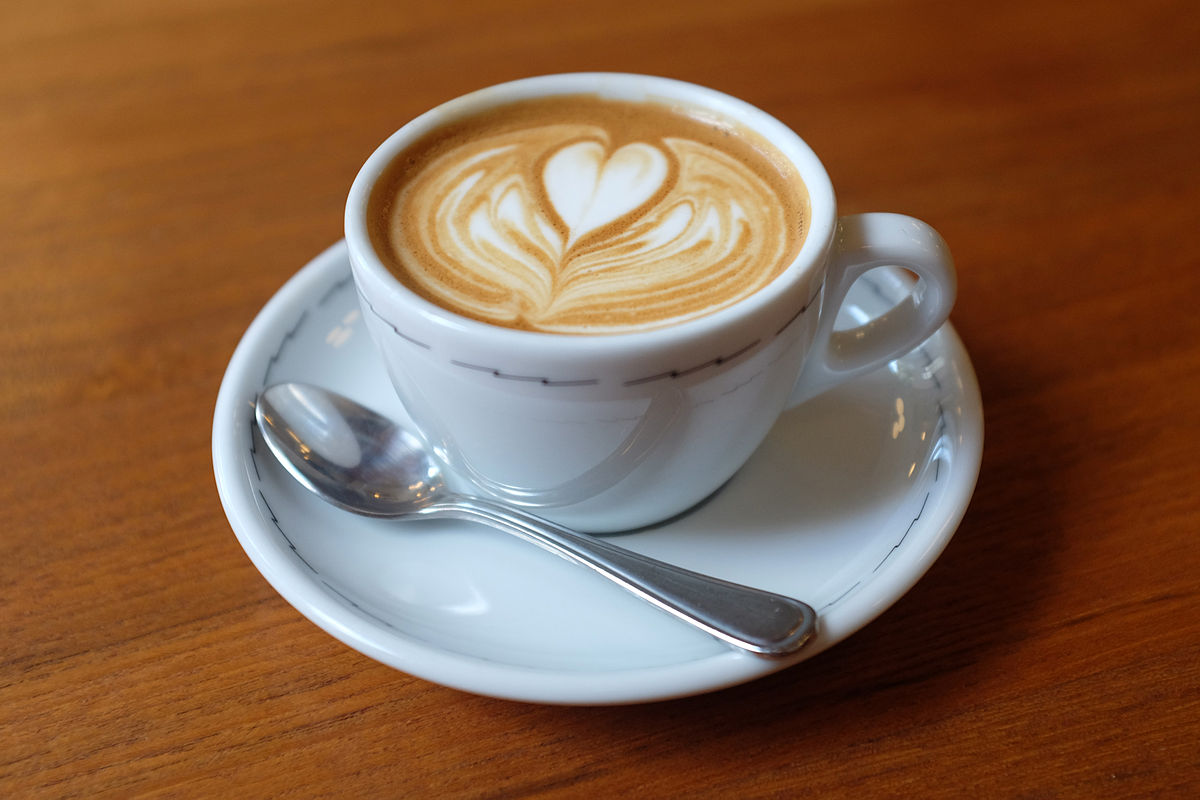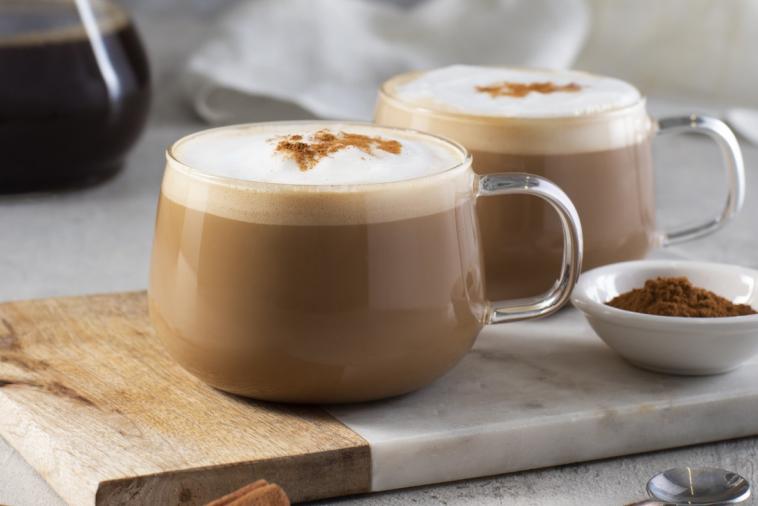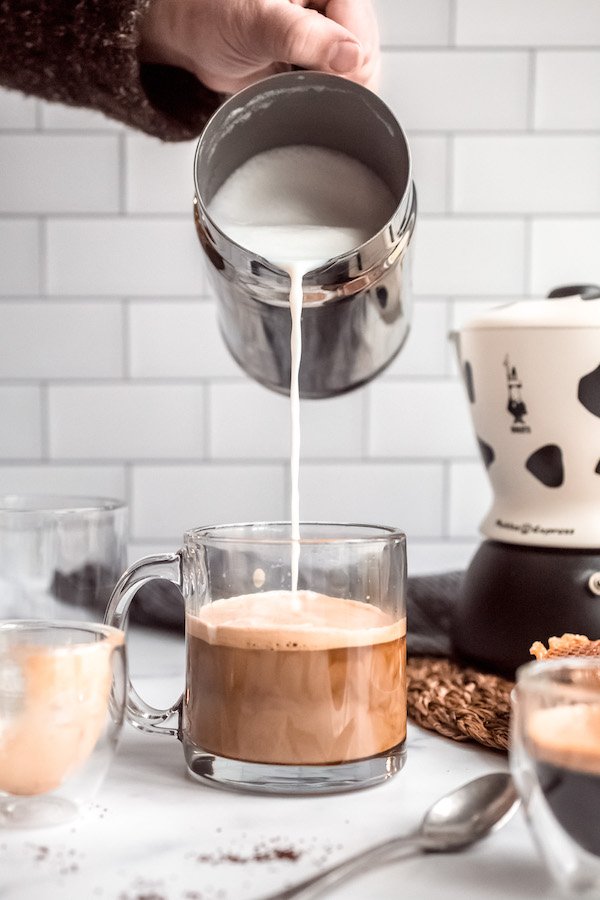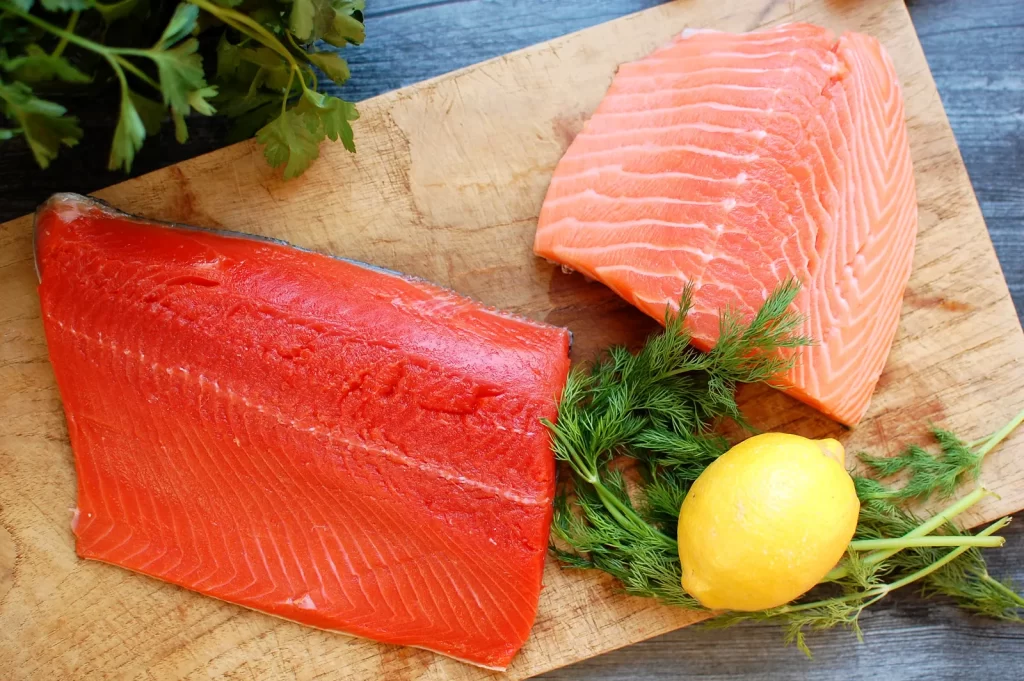Cappuccino and latte are both popular coffee drinks that are enjoyed by many around the world, but they have some key differences. A cappuccino typically consists of equal parts espresso, steamed milk, and frothed milk, giving it a strong espresso flavor with a creamy and frothy texture.
The froth on a cappuccino is quite thick, often allowing for latte art on top. In contrast, a latte is made with a larger proportion of steamed milk to espresso, usually in a 3:1 ratio of milk to espresso. This results in a creamier, smoother beverage that has a more subdued espresso flavor compared to a cappuccino.
Lattes also have a small amount of milk foam on top, but less than what’s found on a cappuccino. Both drinks can be customized with various flavors, but their core compositions define their distinct taste and texture profiles.
What is Cappuccino?
A cappuccino is a popular coffee drink known for its rich flavor and unique texture. It originates from Italy and is traditionally made with three equal parts: one part espresso, one part steamed milk, and one part frothed milk. This combination gives the cappuccino its signature layers.

The espresso provides a strong coffee base, offering a deep and robust flavor. The steamed milk adds creaminess and smoothness to the drink, tempering the intensity of the espresso. The final layer, frothed milk, is airy and light, often forming a thick, velvety foam on top. This froth not only adds a textural contrast but also helps retain the heat of the beverage.
Cappuccinos are often enjoyed at breakfast in Italy and have become popular worldwide, especially in coffee shops and cafes. They can be served plain or with a dusting of cocoa powder or cinnamon on top. The precise proportions and method of preparation can vary, but the classic three-part composition is what fundamentally defines a cappuccino.
What is Latte?
A latte, short for “caffè latte,” which means “milk coffee” in Italian, is a popular coffee beverage known for its smooth and creamy texture. It’s made primarily from two components: espresso and steamed milk.
The typical ratio used is about one-third espresso to two-thirds steamed milk, topped with a small amount of milk foam. This combination results in a milder coffee flavor compared to a cappuccino, due to the higher milk content.

The espresso in a latte provides the coffee base, offering a rich and robust flavor. The large amount of steamed milk not only dilutes the intensity of the espresso but also adds a creamy, velvety texture to the drink. The thin layer of milk foam on top can be used for creating latte art, which has become an artistic expression in many coffee shops.
Lattes are popular around the world and are often customizable with various flavors, such as vanilla, caramel, or hazelnut, by adding flavored syrups. They are typically served in larger cups compared to cappuccinos, due to the higher volume of milk.
A latte offers a gentler coffee experience, making it a favored choice for those who enjoy a creamy and less intense coffee flavor.
Origin and History
Cappuccino and latte, both rooted in Italian coffee culture, have rich histories that reflect the evolution of global coffee traditions. The cappuccino, deriving its name from the Capuchin friars and their brown robes, is a quintessential Italian morning beverage, traditionally consumed at breakfast.
It emerged in Italy in the early 20th century with the advent of espresso machines, which allowed for the creation of its distinctive layers of espresso, steamed milk, and frothed milk. The latte, or caffè latte (‘milk coffee’ in Italian), was originally a homely, breakfast drink in Italian households, simply made with coffee and milk.
It was the American adaptation in the latter part of the 20th century that transformed the latte into the creamy, milk-dominant beverage enjoyed in large cups, becoming a symbol of modern café culture.
These drinks, while sharing Italian roots, diverged in their cultural journey, with the cappuccino maintaining its traditional Italian essence and the latte evolving into a globally popular coffee shop staple.
Difference Between Cappuccino vs Latte
Cappuccino and latte are both espresso-based coffee drinks that are popular worldwide, but they differ significantly in their preparation, texture, and flavor profiles. Here are the key differences:
- Milk to Espresso Ratio:
- Cappuccino: Traditionally, a cappuccino is made with equal parts of espresso, steamed milk, and milk foam, typically in a 1:1:1 ratio.
- Latte: A latte has a higher proportion of steamed milk to espresso, usually around a 3:1 ratio of milk to espresso, with a small layer of milk foam on top.
- Texture and Layering:
- Cappuccino: Known for its distinct layers and rich texture. The equal parts create a balance between the espresso, creamy milk, and the frothy, airy foam on top.
- Latte: Characterized by its creamy texture. The higher milk content creates a smoother, silkier feel, with less foam and more fluid milk.
- Flavor Intensity:
- Cappuccino: Offers a stronger espresso flavor due to the lower milk content. The robust coffee taste is more pronounced.
- Latte: Has a milder and more subdued coffee flavor, as the larger amount of milk dilutes the intensity of the espresso.
- Serving Size:
- Cappuccino: Typically served in smaller cups, which emphasizes its stronger coffee flavor and maintains the heat longer.
- Latte: Served in larger cups or glasses, accommodating the greater volume of milk.
- Cultural Context and Consumption:
- Cappuccino: Often consumed in the morning in Italy and many other parts of Europe.
- Latte: Popular as an all-day drink in many countries, especially in the United States and other parts of the world.
- Customization and Variations:
- Cappuccino: Sometimes dusted with cocoa powder or cinnamon on top.
- Latte: More commonly customized with flavored syrups and elaborate latte art due to its larger surface area of milk foam.
While both are espresso-based, a cappuccino is characterized by its equal parts of espresso, milk, and foam, offering a strong coffee taste with a frothy texture. A latte, on the other hand, is creamier and milder due to its higher milk content, often enjoyed in larger servings, and adaptable to various flavor additions.
Comparison chart
Certainly, here’s a comparison chart that outlines the key differences between Cappuccino and Latte:
| Feature | Cappuccino | Latte |
|---|---|---|
| Espresso Content | One part | One part |
| Steamed Milk | One part | Two to three parts |
| Milk Foam | One part, a thick layer | Thin layer |
| Flavor Intensity | Stronger due to less milk | Milder due to more milk |
| Texture | Rich, with distinct layers | Smooth and creamy |
| Serving Size | Smaller cups (typically 150-180 ml) | Larger cups (typically 240-480 ml) |
| Typical Time of Day | Morning in many European cultures | Enjoyed throughout the day |
| Customization | Sometimes dusted with cocoa or cinnamon | Often flavored with syrups; latte art common |
| Cultural Origin | Italy | Italy, popularized in American coffee culture |
This chart highlights the primary distinctions in ingredients, texture, serving style, and cultural aspects of Cappuccinos and Lattes.
How to make delicious cappuccino
Making a delicious cappuccino involves a balance of properly brewed espresso, steamed milk, and frothed milk.

Here’s a step-by-step guide to help you make a great cappuccino:
Ingredients
- Freshly ground espresso beans
- Cold milk (whole milk is preferred for better frothing)
Equipment
- Espresso machine with a steam wand
- Coffee grinder (if using whole beans)
- Milk frothing pitcher
- Cappuccino cup (typically 150-180 ml)
Steps
- Grind the Coffee:
- Grind your espresso beans to a fine consistency. You’ll need about 18-20 grams of coffee for a double shot of espresso.
- Prepare the Espresso:
- Tamp the ground coffee into the portafilter of your espresso machine.
- Brew a double shot of espresso directly into your cappuccino cup. The brewing time should be about 25-30 seconds.
- Steam the Milk:
- While your espresso is heating Start making your milk steam.
- Fill a milk pitcher about one-third full with cold milk.
- Use the steam wand to heat the milk to about 150-160°F (65-70°C), creating a smooth, velvety texture. Avoid overheating the milk as it can become too thick or scalded.
- Froth the Milk:
- Continue frothing until the milk has doubled in volume with fine, creamy foam. The key is to create microfoam, which is essential for a good cappuccino.
- Combine and Pour:
- First, pour the steamed milk over the espresso. Fill the cup to about two-thirds.
- Then, pour the frothed milk over to complete the filling of the cup. The ideal cappuccino has equal parts of espresso, steamed milk, and frothed milk.
- Serve Immediately:
- Serve your cappuccino as soon as it’s prepared to enjoy its full flavor and ideal temperature.
Tips for a Perfect Cappuccino
- Bean Quality: Use high-quality, freshly roasted beans for the best flavor.
- Milk Temperature: Be careful not to overheat the milk, as this can ruin the taste and texture.
- Practice Frothing: Achieving the perfect microfoam can take practice. The foam should be creamy and not too bubbly.
- Clean Equipment: Always keep your espresso machine and steam wand clean for the best taste and milk texture.
Enjoy your homemade cappuccino! Remember, like any skill, making the perfect cappuccino might take a bit of practice, so don’t be discouraged if your first few attempts aren’t perfect.
How to make a delicious latte
Making a delicious latte is an art that combines well-brewed espresso with smoothly steamed milk.

Here’s a step-by-step guide to help you create a perfect latte:
Ingredients
- Freshly ground espresso beans
- Milk (whole milk steams better and creates richer foam)
Equipment
- Espresso machine with a steam wand
- Coffee grinder (if using whole beans)
- Milk frothing pitcher
- Latte cup (larger than a cappuccino cup, typically 240-480 ml)
Steps
- Grind the Coffee:
- Grind the espresso beans to a fine consistency. You’ll need about 18-20 grams for a double shot of espresso.
- Prepare the Espresso:
- Tamp the ground coffee into the portafilter of your espresso machine.
- Brew a double shot of espresso into your latte cup. The ideal brewing time is around 25-30 seconds.
- Steam the Milk:
- While the espresso is brewing, pour cold milk into your frothing pitcher. Fill it just under half full.
- Make use of the steam wand on an espresso maker to boil the milk. Aim for a temperature of about 150-155°F (65-68°C). You’re looking for milk that is steamed to create a smooth, velvety texture, not just frothy.
- Create Microfoam:
- As you steam the milk, keep the wand near the surface to create a small amount of microfoam. This is less foam than you’d create for a cappuccino.
- The milk should look glossy and have the consistency of wet paint when it’s ready.
- Combine Espresso and Milk:
- First, pour the steamed milk into the cup with the espresso. Do this from a bit of height at first, and then bring the pitcher closer to the cup as it fills up. This helps mix the espresso with the milk.
- Finally, spoon a small amount of the microfoam on top. If you’re skilled at latte art, this is where you would pour the milk to create your design.
- Serve Immediately:
- Enjoy your latte right away to experience the full flavor and ideal temperature.
Tips for a Perfect Latte
- Quality of Beans: Use high-quality, freshly roasted beans for the best flavor.
- Milk Temperature: Be cautious not to overheat the milk as it can scald, affecting the taste.
- Practice Your Pour: The pouring technique is crucial for achieving the perfect mixture of milk and espresso, and for creating latte art.
- Clean Your Equipment: Keep your espresso machine and steam wand clean for the best taste.
Enjoy making your latte! Remember, achieving the perfect balance of espresso and milk might take some practice, so keep experimenting until you find your preferred taste and texture.
Cultural Significance
The cultural significance of cappuccino and latte, while rooted in similar coffee traditions, has evolved differently, reflecting various aspects of global coffee culture.
Cappuccino
- Italian Origins: The cappuccino has its roots in Italy, where it is a staple of Italian coffee culture. It’s traditionally consumed primarily in the morning, often accompanied by a pastry.
- Symbol of Italian Espresso Culture: In Italy, the cappuccino is a symbol of the daily rhythm of life, often enjoyed standing at a bar or café in the morning rush. It is less common to drink a cappuccino after 11 a.m. or after meals, as Italians usually prefer espresso later in the day.
- Global Popularity: Outside Italy, the cappuccino became a symbol of the sophisticated coffee culture. Its popularity spread with the rise of espresso bars and global coffee chains, becoming a favorite in many countries.
- Art and Craftsmanship: The frothy layer of milk foam became a canvas for latte art, showcasing the skill and artistry of baristas worldwide.
Latte
- Italian Breakfast Drink: In Italy, a latte (caffè latte) is typically a home-brewed, morning drink, consisting simply of coffee and milk, often consumed at breakfast.
- American Reinvention: The modern café-style latte that is popular worldwide is more an American invention than a traditional Italian beverage. It gained popularity in the United States, especially in the Pacific Northwest, in the 1980s and 1990s.
- Symbol of Modern Coffee Culture: The latte has come to symbolize modern, urban coffee culture. It is associated with the rise of specialty coffee shops and a more relaxed coffee-drinking experience, often served in large, comfortable cups.
- Canvas for Creativity: The latte, with its large surface area of milk foam, is ideal for latte art, leading to an association with creativity and customization in coffee making.
Comparative Cultural Insights
- Adaptation and Evolution: Both drinks, while having Italian origins, have adapted and evolved in different cultures. The cappuccino and latte in a typical American or international coffee shop can be quite different from their traditional Italian counterparts.
- Time of Day: The cappuccino is traditionally a morning drink in Italy, while lattes are enjoyed throughout the day in many other parts of the world.
- Social Context: Cappuccinos and lattes often reflect different social settings – cappuccinos are quick, morning pick-me-ups, while lattes might be enjoyed leisurely, often in larger servings suitable for a longer coffee break or social meeting.
Both cappuccino and latte have transcended their Italian origins to become integral parts of global coffee culture, each with its unique cultural significance and place in the daily lives of millions around the world.
Healthy Consideration
When considering the health aspects of cappuccino and latte, several factors come into play, including calorie content, nutritional value, and potential health benefits and concerns. Here’s a brief overview:
Cappuccino
- Lower in Calories: Due to its equal parts of espresso, steamed milk, and froth, a cappuccino generally has fewer calories than a latte, especially if made with low-fat or plant-based milk.
- Rich in Antioxidants: The espresso in a cappuccino is rich in antioxidants, which can offer various health benefits.
- Calcium and Protein: The milk provides a good source of calcium and protein.
- Caffeine Content: Like any coffee-based drink, it contains caffeine, which can have both positive and negative effects on health, depending on individual tolerance and consumption quantity.
Latte
- Higher in Calories: Lattes have more steamed milk, which increases the calorie count, especially if made with whole milk or sweetened with syrups.
- Good Source of Calcium and Protein: A larger amount of milk provides more calcium and protein.
- Moderate in Antioxidants: Contains antioxidants from the espresso, though diluted due to the higher milk content.
- Caffeine Considerations: This contains caffeine, but is less concentrated than in a cappuccino due to the higher milk-to-coff ratio.
General Health Considerations
- Sugar and Flavorings: Adding sugar, flavored syrups, or whipped cream can significantly increase calorie and sugar content.
- Lactose Content: For those lactose intolerant or with dairy sensitivities, plant-based milk (like almond, soy, or oat milk) can be a healthier alternatives.
- Caffeine Sensitivity: Individuals sensitive to caffeine should moderate their intake of both beverages.
Both cappuccino and latte can be part of a healthy diet when consumed in moderation and tailored to individual dietary needs. Making mindful choices about milk type, portion size, and added sweeteners can significantly impact their nutritional value.
Final Opinion
Cappuccino and latte, both hailing from Italian coffee traditions, have distinct identities and global footprints. The cappuccino, with its equal layers of espresso, steamed, and frothed milk, remains a symbol of Italian espresso culture, traditionally enjoyed in the mornings.
The latte, characterized by its smooth blend of espresso and steamed milk, has evolved into a staple of modern coffee shop culture, popular for its creamy texture and versatility in flavors.


